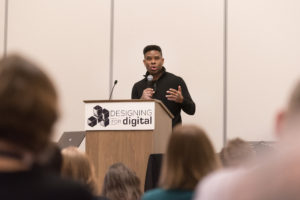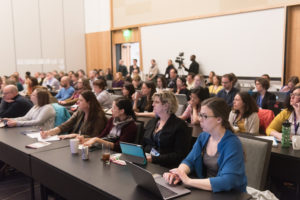Congrats on being a part of the D4D program! We want presenting at D4D to be a fulfilling and fun experience for you and your session attendees. Whether you are presenting for the very first time or this is “old hat” to you, we’ve compiled some tried-and-true tips to help ease any stage-fright jitters and to ensure your presentation is well received.

Framing Your Presentation
Focus on what your audience wants and needs to hear. What message do you want your audience to walk away with?
The presentations that are memorable start strong and tell a story. Grab the audience’s attention right away with a useful image on your opening slide or an intriguing story. Think about the story you want to tell and create your presentation to tell it.
Give a brief introduction, but don’t spend too much time on it. You have a set amount of time to talk and (most likely) have more content than will fit in the given time frame. Briefly introduce yourself (maybe include an image of your library or organization) and jump into your story.

Building Your Slides
Make your presentation accessible to all attendees. Many attendees download the presentation slides for a session to take notes or follow along, particularly if they will be using an accessibility tool on their own computer. We’ve prepared some Accessibility Guidelines for speakers on how to make your slides accessible to screen readers and other accessibility tools.
With text, less is almost always more. Give your text room to breath, don’t crowd too much content on a slide. When there is too much information on a slide, the audience will focus more on reading your slides than listening to you. Text on the slide should complement what you are saying and not be a script of your exact words. Read more about making the text accessible.
Images and other visual aids should speak strongly to your message. The images in your slide deck should support what you are saying or give a deeper dive into the actual data. If its an image, it should be clear why the audience is looking at it. If its data, remember to include a key and make the text large enough so the person in the back row can clearly read it. Images with data should also include alt-text as noted in our Accessibility Guidelines.
Keep an Attentive Audience
Relax and have fun. Once you’re “on stage” and the center of attention it’s completely normal to clam up. Take a deep breath, smile and make eye contact if you can. It will keep you calm and build rapport with the audience. The audience will be emotive if you are and will follow your lead. Show your passion and enjoy yourself!
Pace yourself. Keep your speech at a steady pace and speak slower than you think you need to. It’s natural to speak fast when we’re nervous.
Plan for pauses. After a particularly complex part or after delivering a few minutes of meaty information, force a pause to give the audience time to digest what you are saying (and possibly think of a question to ask you). Plan these forced pauses within your talk and make a note of when to take them.
Engage your audience! Changing up the delivery every 9-10 minutes will keep it from becoming monotonous. Ask a question that a quick hand raise can answer. Use tools like polleverywhere.com if you’re confident.
Wrapping Up
Give the audience a few moments to collect their thoughts before starting the Q&A. Once your presentation is almost over, it will be time for some Q&A. Tell the audience that you are going to give them a minute or two to collect their thoughts and think of any questions they’d like to ask. Sometimes the brief, calm silence of a room or being able to quickly chat with the person sitting next to you can curate interesting questions.
Important Reminders:
When the audience asks questions, they will need to speak into the audience microphone so the Online Conference attendees can hear them. Gesture to the aisle mic or have the room moderator bring the microphone to them. This is a very important note to remember, we cannot stress enough that speakers and audience members asking a question must speak into the microphone.
If your session is live-streamed, welcome the Online Conference attendees and welcome their questions in the chat section. A moderator will be in the room to moderate these questions.
End on a high note. Hold back 30-60 seconds of your content to wrap up the session post-Q&A. You want your audience leaving your session remembering your message, not a room looking around anxiously for more audience questions to arise.
Include your email or Twitter handle on the final slide. Some attendees may have questions but may not be comfortable speaking up during the session or they may think of a question post-conference. If you would like to keep the dialogue going, give them an opportunity to engage with you after the session by providing contact information. Keep the slide up long enough for them to write down the information you include.

Final Notes
All peer-reviewed sessions will be recorded so you may see a camera in the room. Some rooms will only have computer-screen capture but won’t have a camera. Pretend the camera is just another attendee.
Calm any nerves and work out any kinks in the delivery by practicing and practicing again. Once you arrive in Austin, take a walk around the conference center and find the room your presentation will be in. During breakfast, a break or lunch peek into the room to get the lay of the land. Starting Sunday, March 8th, the Speaker Ready Room on M1 will be available to all D4D presenters to walk through their presentation at a podium.
We encourage pre-show promotion and engagement. If you are excited about your session or want to promote it, feel free! You can find your Sched link — our official program — and send that to colleagues, on social media, etc. If you want to pre-poll your audience, you can include a link to a web survey or poll directly in the session.
Have questions, concerns or need some extra assistance? No time is the wrong time to ask. Contact us prior to the conference at [email protected] or onsite at the Registration Desk on M2.
